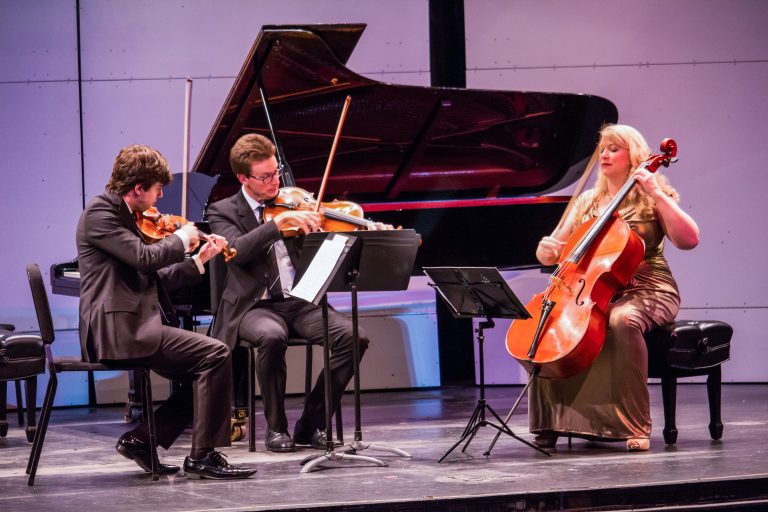
Sophia Tao
An eager audience waited in Lotte Lehmann Concert Hall to witness four esteemed faculty members of UCSB’s Department of Music perform chamber music on the evening of Thursday, April 12. The string musicians tuned their instruments in the background to the excited murmurs of the audience, composed of smartly dressed middle-aged adults and students.
The Department of Music has not had a faculty recital in many years which made the performance a special occasion for concert attendees. Attendees saw their professors play professionally, outside of the usual classroom context.
The world-class musicians who performed were violinist Ambroise Aubrun, violist Jonathan Moerschel, cellist Jennifer Kloetzel, and pianist Robert Koenig. Aubrun has a first prize diploma from the Paris National Superior Conservatory. Moerschel made his solo debut in the Boston Symphony Hall more than twenty years ago.
Kloetzel is a Juilliard graduate and Fulbright scholar and has recorded music for the soundtrack of “House of Cards“ seasons two and four. Among Koenig’s many achievements, he was nominated for “Best Instrumental Soloist Performance (without orchestra)” at the 49th annual Grammy Awards.
A hush fell over the crowd as the lights dimmed, and Dr. Derek Katz, musicologist and associate professor, walked onstage to present a pre-concert lecture. He introduced the first piece, Romanian composer George Enescu’s “Aubade in C Major for String Trio,” published in 1899. According to Kloetzel, if a serenade is played in the evening to seduce someone, then an aubude is played in the morning after the serenade is successful.
Enescu’s “Aubade” is a lighthearted piece that runs around four and a half minutes. With a quick tempo and light pizzicato, “Aubade” evoked the happy and peaceful feeling of daytime sunlight. Aubrun demonstrated his mastery of the violin, playing high notes with incredible ease. “Aubade“ ended with a gradual fade that had the audience captivated until the end, whereafter an audience member audibly “wowed.”
The musicians next performed Czech composer Antonín Dvořák’s “Piano Quartet No. 2 in E-flat Major, Op. 87,” published in 1889, which runs around 35 minutes and is split into four movements. The movements are “Allegro con fuoco,” “Lento,” “Allegro moderato, grazioso,” and “Allegro ma non troppo.” Koenig joined the string trio to perform this piece.
The piece was performed with such casual grace which didn’t reveal the fact that the arrangement is known for its difficulty. Although this was the first time all four faculty members performed together, the performers were clearly familiar with each other in the way they breathed and moved as one, communicating wordlessly through eye contact.
Koenig’s skill shone during “Allegro con fuoco” in the clarity and precision of each note he played, despite the brisk pace. Kloetzel’s playing took the spotlight with multiple melancholy solos during “Lento,” which was noticeably slower. Moerschel also captured attention with his expressive body language, facial expressions, and steady accompaniment. The ending of “Lento” was gradually drawn out which made the audience hold its breath and freeze until the performers broke the spell when they moved on to the next movement.
In contrast to “Lento,” the third movement plunged forward with an upbeat tempo that inspired toe-tapping and head-bobbing. “Allegro moderato, grazioso” contained an “exotic” Slavic melody that Katz played on the grand piano earlier during his pre-concert lecture for the audience. Katz explained that the Slavic melody is the only folk sound in a piece that has no overall folk association, which is surprising given Dvořák’s “brand” of traditional folk music.
The finale, “Allegro ma non troppo,” furiously raced towards its finale. Dramatic flourishes of the string musicians’ bows emphasized the finale. Thunderous applause followed.
The night was a success in terms of the performance, and it was also a success in terms of making a musical style more accessible. This style is sometimes considered a highbrow niche. Furthermore, the event’s free admission incentivized community members of all stripes to come and gain exposure to classical music.
There was a reception afterwards which allowed concert attendees to interact with the performers and ask questions. “Music [is] very much about community. We want to feel a connection to the people onstage […and] that [we’re] participating as part of a community,” said Katz in an interview with The Bottom Line. Ultimately, the event succeeded in making everyone feel connected to the music and the community.
An early version of this article referred to Robert Koenig as “she.” Koenig identifies as male.










